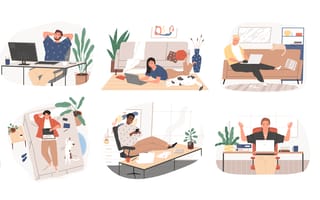It’s not surprising that SquareFoot, which specializes in commercial real estate, is eager to get back to the office. So last month, the New York City-based tech company allowed employees to start working at the office again if they wanted.
When COVID-19 forced businesses across the country to shut down in March, Michael Colacino had been president of the company for only four months. He found that the types of interactions he had with coworkers changed as a result of the lockdown.
“In my first months, pre-COVID, I had dozens and dozens of interactions with younger people in the company, who would come over and just ask me a quick question,” Colacino said. “Since COVID started and we’ve gone into the full work-from-home program, I’ve had two.”
He worried that employees would miss out on the “watercooler effect” — serendipitous encounters at the office that lead to valuable work insights, which were unlikely to happen with everyone working remote. Those interactions are “not scheduled, not programmed, driven by a hundred different little interactions that go on during the day,” Colacino said.
He was also concerned about practical workflow problems that arise when people work remotely, such as communication errors that affect projects at critical checkpoints.
“As someone who’s trying to build a company, I try to create projects that move through the organization,” Colacino said. “And the transition of those projects from one part of the company to another is a very vulnerable time. It’s where a lot of projects get sidetracked. It’s not like [people don’t do the work] — it’s when that work is done, handing it off to the next group, and then the next group — that’s where all of the breakdowns occur.”
Colacino referred to Reengineering the Corporation, a book by Mike Hammer, which argues that most of the wasted time and effort at work happens “in between things,” like between the stages of a process, or when handing off work between people.
Working remotely was also tricky for SquareFoot because of the business it is in.
“The brokerage group, they have to be there physically in Midtown or Downtown,” Colacino said.
Brokers need to show real estate to potential clients, which is logistically difficult without a central office nearby to operate out of.
“The way a broker’s day may work is you come in the morning, you go out and you meet your clients, you look at the space in the morning and maybe afternoon, [then] you come back and write up your notes,” Colacino said. “It used to be that it was very popular to have in-office debrief meetings with your clients. So all of these are things that you kind of need to do in the city.”

Hacking Together a Solution
SquareFoot knew that these changes were going to be challenges for the company, so, early on, it started brainstorming ways to ease the transition back to working in the office.
“We knew that this was going to be an issue months ago,” Colacino said. “And so we brought all of our people together, and we did a two-day hackathon, which came up with a bunch of ideas that we subsequently implemented.”
The company eventually turned the ideas from the hackathon into an application currently used to portion out time at the office to each employee. SquareFoot approached the problem by thinking of the office as “a resource to be allocated,” as opposed to simply a space where people congregate. Prior to COVID, the office accommodated 59 employees. Now, because of social distancing requirements, the capacity is cut in half, at about 27 employees.
As a resource, the office became a sort of precious commodity that should be allocated to the teams that needed it most. The next step was determining which teams those were.
“The way that we approached it was, we started out by doing a self-assessment by all the managers of the different parts of the company, on how much they needed to have this resource available to them,” Colacino said.
The survey was broken down into four categories: amenities, communication, location and professional development. In the amenities category, for instance, each manager rated the impact of having office amenities such as high-speed internet access, whiteboards, conference rooms and limited-license tools on their team’s ability to get work done.
“This is a very, very complicated question.”
The survey also asked about considerations such as access to mass transit, with the understanding that employees may be more reluctant to travel to the office if the most feasible way to get there is on the subway.
SquareFoot then took the responses from the survey and calculated a score based on a weighted average of answers within categories. Teams were allocated different percentages of time in the office, depending on the results. The real-estate brokerage team, for example, made up 30 percent of employees at the company, but were granted 49 percent of the use of the office.
But it was also important to have some flexibility built into the application, Colacino said.
“The organizations are important, but the individuals are also important,” he said. “We have an individual component, which takes into account the department’s score and gives people a certain amount of time based upon the department, up to a certain limit. Then above that you can get more time, but it’s at a much lower rate.”
This way, special circumstances could be accommodated, but, most of the time, office time is determined based on the department rate.
“This is a very, very complicated question. There’s so many layers to this subject,” Colacino said. “While the algorithm that we came up with I think is a good starting place, it almost creates as many questions as answers.”

Putting the Tool to the Test
SquareFoot began using the application when it reopened its office on July 13, following city requirements for wearing masks while at the office.
“There hasn’t been an overwhelming stampede of people wanting to get back in,” Colacino said. “So we’ve got a bunch of masked desperados in our office, and it’s not very pleasant to have to spend your day wearing a mask, trying to communicate with other people.... It was really weird because we had a Zoom call the other day with a lot of people who had come into the office, and they were wearing masks and we weren’t. We actually felt superior.”
Because most employees are still opting to stay remote, the application isn’t yet being used to its full capacity, and there are still components — such as an online reservation system — that need to be added. But for SquareFoot, the important part is having a tool in place to handle requests when more people eventually want to return to the office, and not get overwhelmed.
“Our big concern is what happens when everybody wants to come back in,” Colacino said. “How do we make sure that we let people back in an organized way?”




